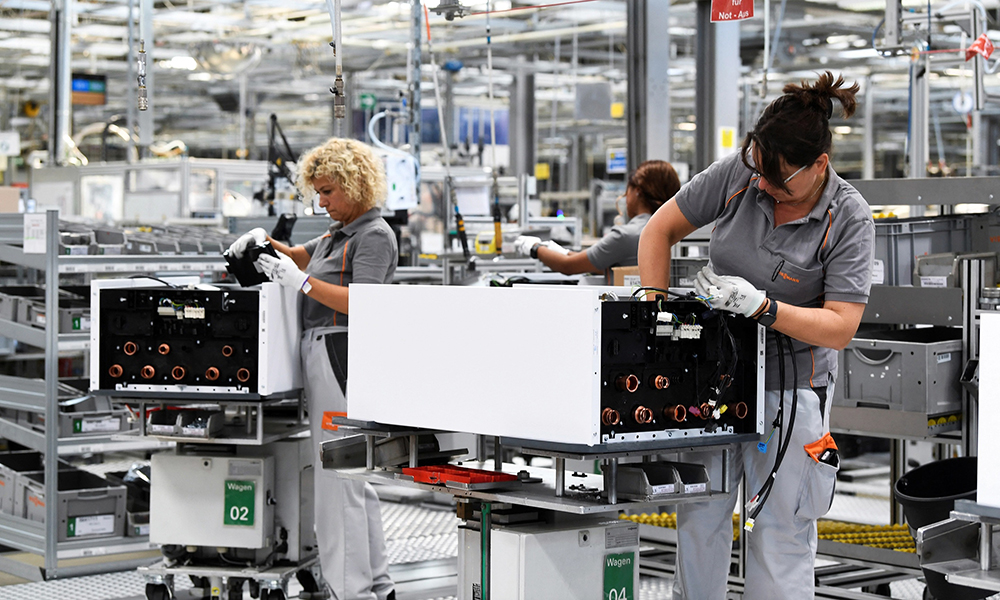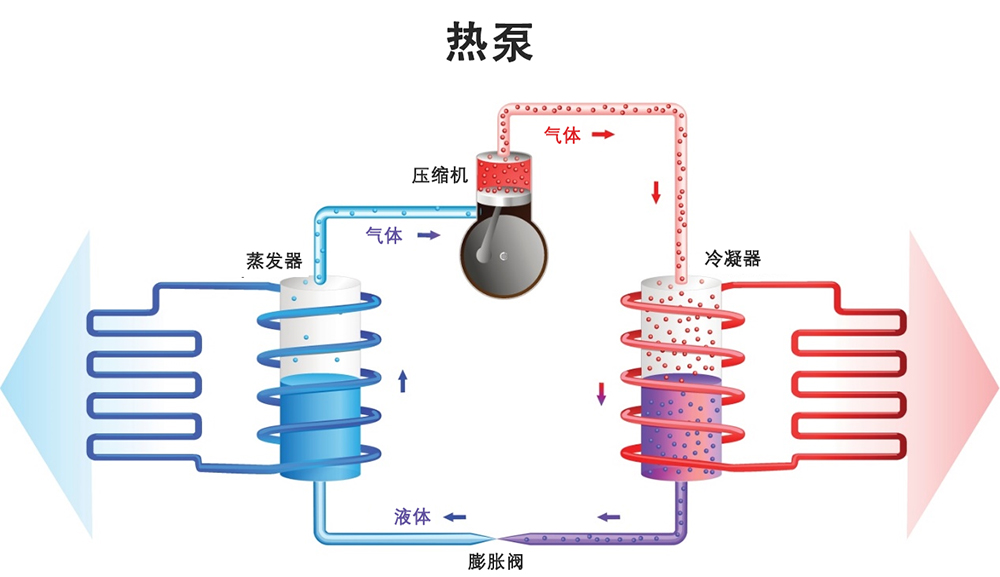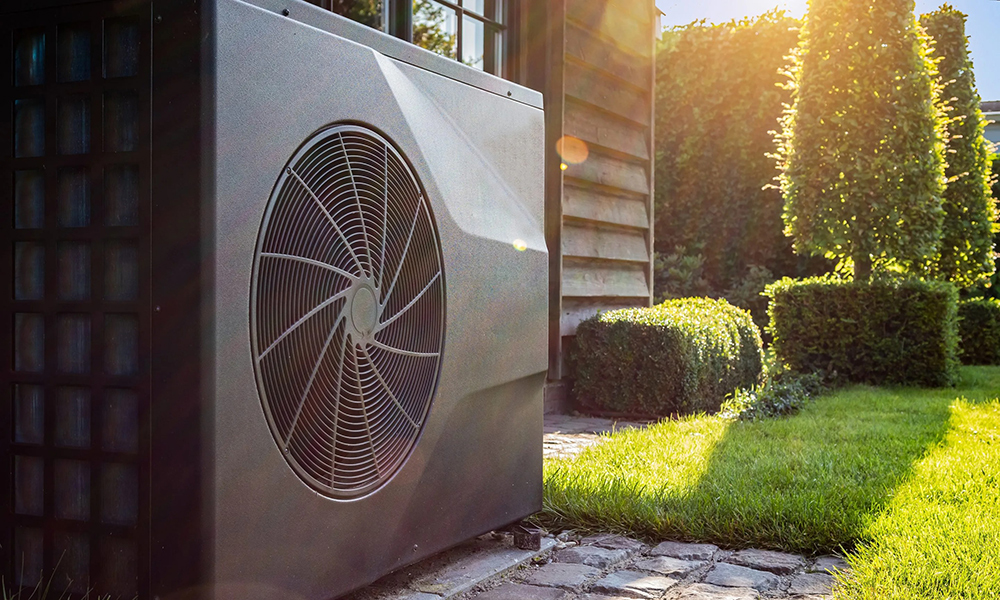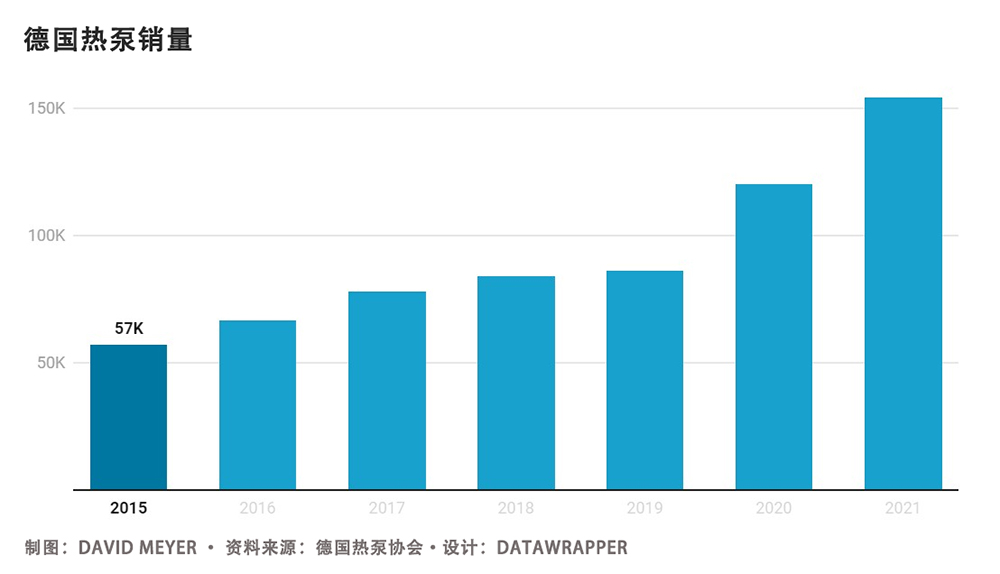
普遍的能源危机?通胀高企?如果说历史有规律,那么2022年就让人回想起20世纪70年代。当时,1973年的中东战争和1979年的伊朗革命这两场灾难,导致中东地区的石油出口严重中断,随后引发的能源危机令西方经济陷入衰退,让许多人警醒寻找替代能源的必要性。
这场危机让19世纪中叶问世的一种技术开始走红,它就是热泵,即将地面、水和空气中的热量输送到建筑当中。公司竞相投资这种笨重的、让人难以形容的方盒子,但随着危机结束,化石能源价格回落,这种简陋的热泵基本被淘汰。
如今,俄罗斯的天然气战略迫使欧洲关闭工厂,面对寒冬陷入绝望,这时候人们又想起了热泵。而这一次,日益严重的气候危机需要快速采用可再生能源,这意味着热泵可能不会退出历史舞台。
德国供暖和制冷巨头菲斯曼集团(Viessmann)的首席执行官马克思·菲斯曼说:“我们有解决方案。[热泵]实际上比人们想象的更先进,而且现在它们需要扩大规模。”
450%的效率
热泵系统由建筑外部和内部的连接设备组成,造型上或许毫无吸引力:最常见的空气源热泵与大型空调机的外形类似,但它们非常高效。

虽然基于煤气炉的供暖系统最高效率为95%,即每燃烧100个单位的能量可以释放95个单位的能量,但现代热泵的效率高达450%。在系统中投入1个单位的电能,通常至少能够输出4.5个单位的热能。首先,系统释放的热量已经存在于大气当中,这与化石能源产生的能量不同。
据国际能源署(International Energy Agency)2021年11月的报告显示,美国接近一半新建多户住宅和超过40%的新建单户住宅,都安装了热泵,不难看出背后的原因。旧建筑也开始安装热泵,尽管这意味着需要在墙上开洞,还要重新进行电气连接,因此目前这种旧房改造依旧是相对较小的市场。热泵的价格当然高于污染更严重的同类产品,但它们的运行成本低得多。根据房屋的尺寸,热泵的售价可能达到数万美元。

热泵还有额外的好处:大多数热泵还可以作为制冷系统。与冰箱和空调一样,热泵使用名为制冷剂的液体输送热量,只是它们从外向内输送,而不是从内向外输送。大多数空气源热泵和水源热泵都能够进行反向操作,将室内温度降低5摄氏度。在气候更温暖的地区,热泵当然不能取代空调,但在欧洲所处的温带,并不常用空调,高温却变得日益普遍和极端,因此热泵的制冷效果是一个重要的卖点。
这意味着热泵会迎来大量投资。
热泵投资
已经有105年历史的菲斯曼集团最近宣布,未来三年将在热泵和其他绿色产品领域投资10亿美元。
菲斯曼是德国被称为中小企业的中等家族企业的典型代表,这些中小企业是德国经济的支柱。德国正在紧急采取措施,应对快速气候变化和关系国家存亡的能源危机。马克思是该家族企业的第四代掌门人,目前公司市值达到34亿美元。菲斯曼在1979年推出了第一款热泵,但随着能源危机结束,这项技术便被封存。二十年前,该公司重启热泵业务,去年在德国的市场份额达到约15%。
现在,菲斯曼需要维护其作为德国市场领导者之一的地位,因为其竞争对手正在加大对热泵技术的投入。
有98年历史的供暖公司世创电能(Stiebel Eltron)在20世纪70年代进军热泵业务,并且从未放弃,尽管该技术成为公司的亏损大户,直到最近才有所好转。去年,为了满足需求,公司热泵产量增长了60%。现在,世创电能成为欧洲前五大热泵生产商之一,今年8月宣布未来五年将再投资6亿美元用于热泵生产和研发。
该公司是总经理石富本(Kai Schiefelbein)表示:“尽管天然气会产生大量二氧化碳,但人们还是会首选使用天然气,这时候,这种更昂贵的设备就很难销售,即使它的二氧化碳排放更低。目前的状况是,由于气候保护的原因,欧洲热泵市场正在快速增长。”
事实上,虽然乌克兰危机导致今年热泵需求激增,许多买家要等几个月才能够收到新热泵,但从2019年以来,德国的热泵需求便已经在大幅增长,当时德国政府为了努力实现其气候目标增加了对热泵的补贴。
在全世界,建筑供暖、制冷和供电占温室气体排放量的四分之一。据政府支持的气候透明组织(Climate Transparency)统计,2020年,德国人均建筑相关碳排放量比G20国家平均水平高56%,主要原因是建筑普遍使用天然气和石油供暖。这导致供暖和交通运输,成为立法者关注的首要目标。
随着新补贴政策的实施,从2019年到2020年,德国热泵销量增长了40%,2021年又增长了28%,达到154,000台,其中有900,000台在本土销售。(据国际能源署统计,2020年全球共安装热泵1.77亿台,之前五年每年增长约10%。)

今年8月,注重环保的德国新政府改革了补贴制度,将热泵的最高补贴从标价的50%下降到40%。
这对热泵行业影响不大,因为政府还停止向燃气锅炉和基于石油的供热系统发放补贴。目前燃气锅炉依旧是最常用的建筑供暖方式。德国政府承诺将制定一项法律,要求所有新供暖系统使用的可再生能源不少于65%。
德国热泵协会(German Heat Pump Association)的宣传总监卡帝亚·魏因霍尔德说:“为了保障热泵行业能够提前进行规划并且保证规划的执行,必须有明确的法律规定,这非常重要。这将发出重要的信号,向外界表明德国的标准做法不再是安装燃气锅炉,而是电气热泵。”
65%的规定并没有最终确定,这是目前让热泵行业担心的多个不确定性之一。
芯片、技术和氟化气体
但有一个迫在眉睫的问题,尤其是在热泵需求激增的情况下,那就是全球芯片荒。世创电能的石富本称:“目前很难买到微芯片,尤其是处理器。”马克思·菲斯曼表示:“芯片的主要供应对象是汽车行业。我们是需要更多汽车,还是更多热泵,让我们的家庭和工业生产变得不依赖[化石能源]?”
Rystad Energy的高级分析师拉尔斯·伊瓦尔·尼特·哈弗罗称,芯片供应链依旧“可以感受到新冠疫情造成的一些后续影响”。他预计到2050年,全球热泵需求将增长7倍。
另外一个严重的不确定性是热泵运行所需要的制冷剂。目前使用的制冷剂通常是所谓的氟化气体,例如氢氟碳化合物,讽刺的是,如果这种气体从系统中泄露,其全球变暖潜力就是二氧化碳的1,700倍。
欧洲可能在今年晚些时候命令淘汰这类物质,这将令热泵行业陷入困境。一些公司已经开始采用天然的、更环保的替代品,比如菲斯曼的部分产品使用丙烷,但许多人担心过快转型会在需求最旺盛的时候,扼杀热泵市场。
石富本认为:“与能效增益相比,制冷剂对气候的影响很小。当然,所有人都希望热泵中使用丙烷这种天然的制冷剂,但如果我们太快淘汰氟氯烃,就会降低整个热泵市场的增长速度……许多产品目前无法使用天然制冷剂。我个人建议,如果有新热泵首次投放市场,那么[规则可以要求]这类产品就必须使用天然制冷剂。”
安装热泵的熟练技术工人不足是热泵行业面临的另外一个问题,还有一个关键问题是,如何保证用户的住宅隔热性能良好,足以让他们安装的热泵充分发挥作用。关于应该用多大力度强制人们安装热泵,这也是一个未知数。马克思·菲斯曼警告,德国采取过于严厉的做法,可能引发类似于法国的“黄马甲运动”。黄马甲运动是法国因为高能源价格而引发的暴动。
但热泵的环保效益是显而易见的,而且全世界的政策制定者都看好这项技术。例如,占全球热泵市场一半规模的美国,将进一步通过《通胀削减法案》(Inflation Reduction Act)中的补贴鼓励安装热泵。
与电动汽车一样,热泵证明,全世界应对气候危机所需要的技术,大多数都是现成的,问题只是如何将它们变成我们默认的选择。(财富中文网)
译者:刘进龙
审校:汪皓
普遍的能源危机?通胀高企?如果说历史有规律,那么2022年就让人回想起20世纪70年代。当时,1973年的中东战争和1979年的伊朗革命这两场灾难,导致中东地区的石油出口严重中断,随后引发的能源危机令西方经济陷入衰退,让许多人警醒寻找替代能源的必要性。
这场危机让19世纪中叶问世的一种技术开始走红,它就是热泵,即将地面、水和空气中的热量输送到建筑当中。公司竞相投资这种笨重的、让人难以形容的方盒子,但随着危机结束,化石能源价格回落,这种简陋的热泵基本被淘汰。
如今,俄罗斯的天然气战略迫使欧洲关闭工厂,面对寒冬陷入绝望,这时候人们又想起了热泵。而这一次,日益严重的气候危机需要快速采用可再生能源,这意味着热泵可能不会退出历史舞台。
德国供暖和制冷巨头菲斯曼集团(Viessmann)的首席执行官马克思·菲斯曼说:“我们有解决方案。[热泵]实际上比人们想象的更先进,而且现在它们需要扩大规模。”
450%的效率
热泵系统由建筑外部和内部的连接设备组成,造型上或许毫无吸引力:最常见的空气源热泵与大型空调机的外形类似,但它们非常高效。
虽然基于煤气炉的供暖系统最高效率为95%,即每燃烧100个单位的能量可以释放95个单位的能量,但现代热泵的效率高达450%。在系统中投入1个单位的电能,通常至少能够输出4.5个单位的热能。首先,系统释放的热量已经存在于大气当中,这与化石能源产生的能量不同。
据国际能源署(International Energy Agency)2021年11月的报告显示,美国接近一半新建多户住宅和超过40%的新建单户住宅,都安装了热泵,不难看出背后的原因。旧建筑也开始安装热泵,尽管这意味着需要在墙上开洞,还要重新进行电气连接,因此目前这种旧房改造依旧是相对较小的市场。热泵的价格当然高于污染更严重的同类产品,但它们的运行成本低得多。根据房屋的尺寸,热泵的售价可能达到数万美元。
热泵还有额外的好处:大多数热泵还可以作为制冷系统。与冰箱和空调一样,热泵使用名为制冷剂的液体输送热量,只是它们从外向内输送,而不是从内向外输送。大多数空气源热泵和水源热泵都能够进行反向操作,将室内温度降低5摄氏度。在气候更温暖的地区,热泵当然不能取代空调,但在欧洲所处的温带,并不常用空调,高温却变得日益普遍和极端,因此热泵的制冷效果是一个重要的卖点。
这意味着热泵会迎来大量投资。
热泵投资
已经有105年历史的菲斯曼集团最近宣布,未来三年将在热泵和其他绿色产品领域投资10亿美元。
菲斯曼是德国被称为中小企业的中等家族企业的典型代表,这些中小企业是德国经济的支柱。德国正在紧急采取措施,应对快速气候变化和关系国家存亡的能源危机。马克思是该家族企业的第四代掌门人,目前公司市值达到34亿美元。菲斯曼在1979年推出了第一款热泵,但随着能源危机结束,这项技术便被封存。二十年前,该公司重启热泵业务,去年在德国的市场份额达到约15%。
现在,菲斯曼需要维护其作为德国市场领导者之一的地位,因为其竞争对手正在加大对热泵技术的投入。
有98年历史的供暖公司世创电能(Stiebel Eltron)在20世纪70年代进军热泵业务,并且从未放弃,尽管该技术成为公司的亏损大户,直到最近才有所好转。去年,为了满足需求,公司热泵产量增长了60%。现在,世创电能成为欧洲前五大热泵生产商之一,今年8月宣布未来五年将再投资6亿美元用于热泵生产和研发。
该公司是总经理石富本(Kai Schiefelbein)表示:“尽管天然气会产生大量二氧化碳,但人们还是会首选使用天然气,这时候,这种更昂贵的设备就很难销售,即使它的二氧化碳排放更低。目前的状况是,由于气候保护的原因,欧洲热泵市场正在快速增长。”
事实上,虽然乌克兰危机导致今年热泵需求激增,许多买家要等几个月才能够收到新热泵,但从2019年以来,德国的热泵需求便已经在大幅增长,当时德国政府为了努力实现其气候目标增加了对热泵的补贴。
在全世界,建筑供暖、制冷和供电占温室气体排放量的四分之一。据政府支持的气候透明组织(Climate Transparency)统计,2020年,德国人均建筑相关碳排放量比G20国家平均水平高56%,主要原因是建筑普遍使用天然气和石油供暖。这导致供暖和交通运输,成为立法者关注的首要目标。
随着新补贴政策的实施,从2019年到2020年,德国热泵销量增长了40%,2021年又增长了28%,达到154,000台,其中有900,000台在本土销售。(据国际能源署统计,2020年全球共安装热泵1.77亿台,之前五年每年增长约10%。)
今年8月,注重环保的德国新政府改革了补贴制度,将热泵的最高补贴从标价的50%下降到40%。
这对热泵行业影响不大,因为政府还停止向燃气锅炉和基于石油的供热系统发放补贴。目前燃气锅炉依旧是最常用的建筑供暖方式。德国政府承诺将制定一项法律,要求所有新供暖系统使用的可再生能源不少于65%。
德国热泵协会(German Heat Pump Association)的宣传总监卡帝亚·魏因霍尔德说:“为了保障热泵行业能够提前进行规划并且保证规划的执行,必须有明确的法律规定,这非常重要。这将发出重要的信号,向外界表明德国的标准做法不再是安装燃气锅炉,而是电气热泵。”
65%的规定并没有最终确定,这是目前让热泵行业担心的多个不确定性之一。
芯片、技术和氟化气体
但有一个迫在眉睫的问题,尤其是在热泵需求激增的情况下,那就是全球芯片荒。世创电能的石富本称:“目前很难买到微芯片,尤其是处理器。”马克思·菲斯曼表示:“芯片的主要供应对象是汽车行业。我们是需要更多汽车,还是更多热泵,让我们的家庭和工业生产变得不依赖[化石能源]?”
Rystad Energy的高级分析师拉尔斯·伊瓦尔·尼特·哈弗罗称,芯片供应链依旧“可以感受到新冠疫情造成的一些后续影响”。他预计到2050年,全球热泵需求将增长7倍。
另外一个严重的不确定性是热泵运行所需要的制冷剂。目前使用的制冷剂通常是所谓的氟化气体,例如氢氟碳化合物,讽刺的是,如果这种气体从系统中泄露,其全球变暖潜力就是二氧化碳的1,700倍。
欧洲可能在今年晚些时候命令淘汰这类物质,这将令热泵行业陷入困境。一些公司已经开始采用天然的、更环保的替代品,比如菲斯曼的部分产品使用丙烷,但许多人担心过快转型会在需求最旺盛的时候,扼杀热泵市场。
石富本认为:“与能效增益相比,制冷剂对气候的影响很小。当然,所有人都希望热泵中使用丙烷这种天然的制冷剂,但如果我们太快淘汰氟氯烃,就会降低整个热泵市场的增长速度……许多产品目前无法使用天然制冷剂。我个人建议,如果有新热泵首次投放市场,那么[规则可以要求]这类产品就必须使用天然制冷剂。”
安装热泵的熟练技术工人不足是热泵行业面临的另外一个问题,还有一个关键问题是,如何保证用户的住宅隔热性能良好,足以让他们安装的热泵充分发挥作用。关于应该用多大力度强制人们安装热泵,这也是一个未知数。马克思·菲斯曼警告,德国采取过于严厉的做法,可能引发类似于法国的“黄马甲运动”。黄马甲运动是法国因为高能源价格而引发的暴动。
但热泵的环保效益是显而易见的,而且全世界的政策制定者都看好这项技术。例如,占全球热泵市场一半规模的美国,将进一步通过《通胀削减法案》(Inflation Reduction Act)中的补贴鼓励安装热泵。
与电动汽车一样,热泵证明,全世界应对气候危机所需要的技术,大多数都是现成的,问题只是如何将它们变成我们默认的选择。(财富中文网)
译者:刘进龙
审校:汪皓
A widespread energy crisis? Rampant inflation? If history rhymes, 2022 is crammed with callbacks to the 1970s. Back then, the double whammy of 1973’s Arab-Israeli war and 1979’s Iranian revolution caused major interruptions to the Middle East’s oil exports, with the ensuing energy crisis feeding Western recessions and alerting many to the need for alternative energy sources.
The crisis marked the coming-of-age for a technology first developed in the mid-19th century: the heat pump, which transfers heat from the ground, water, and air into buildings. Companies raced to invest in these large, nondescript boxes, but then the crisis ended, fossil fuels became cheap again, and the humble heat pump was largely cast aside.
Now, with Russian natural-gas machinations forcing Europe to shutter factories and stare down the barrel of a cold winter, the heat pump is back. And this time around, the cascading climate crisis—which demands rapid adoption of renewable energy sources—means it’s likely to stay.
“The solutions are available,” said Max Viessmann, CEO of the German heating and cooling giant Viessmann. “[Heat pumps] are actually much more advanced than people realize, and they now need to be scaled.”
450% efficiency
Heat pump systems, which comprise connected devices outside and inside the buildings they serve, may not be much to look at: Air-source heat pumps, which are the most common type, resemble large air-conditioning units—but they are remarkably efficient.
While a gas-furnace–based heating system is at best 95% efficient—that is, it delivers 95 units of energy for every 100 units it burns—modern heat pumps are upwards of 450% efficient. Put one unit of electrical energy in, to power the system, and you will typically get at least 4.5 units of thermal energy out. And the heat that emerges from the system was already in the atmosphere to start with, unlike the energy you get from fossil fuels.
So it’s not hard to see why nearly half of new multifamily buildings in the U.S. and more than 40% of new single-family homes, are being built with heat pumps, according to a November International Energy Agency (IEA) report. Older buildings can also be retrofitted with heat pumps, though this means knocking a hole in the wall and installing new electrical connections, making it a relatively small part of the market for now. Heat pumps are certainly more expensive to buy than their dirtier counterparts—depending on the property size, they can easily run into the tens of thousands of dollars—but they’re a lot cheaper to operate.
Heat pumps have an added bonus: Most can act as cooling systems as well. Like refrigerators and air conditioners, heat pumps use fluids called refrigerants to transfer heat—they just do it from outside in, rather than inside out. Reverse the system, as is possible with most air- and water-source heat pumps, and you can lop as much as 5°C off indoor temperatures. That won’t replace proper air-conditioning in warmer climes, but it’s a big selling point in a relatively temperate region like Europe, where AC is rare but heat waves are becoming more common and extreme.
Cue a fresh flood of investment.
Heat pump investments
Viessmann, a 105-year-old business, recently announced a $1 billion investment into heat pumps and other green products over the next three years.
The firm is a classic example of a Mittelstand midsize family business, a category that forms the backbone of the economy in Germany—a country that’s racing to respond to both rapid climate change and an existential energy crisis. Max represents the fourth generation of his clan to lead the $3.4 billion company. Viessmann introduced its first heat pump in 1979, only to mothball the technology after that energy crisis faded. But it got back into the heat pump business a couple decades ago, and last year it held around 15% of the German market.
Now Viessmann needs to defend its position as one of the country’s market leaders as its rivals sink more money into heat pump technology.
Stiebel Eltron, a 98-year-old heating firm, got into the heat pump business in the 1970s and stuck with it despite the technology becoming a big money loser until relatively recently. The company boosted heat pump production by 60% over the past year to meet demand. It’s now one of Europe’s top five heat pump manufacturers and announced a fresh $600 million investment in heat pump production and R&D over the next five years in August.
“In a world where no one thought twice about using gas and emitting loads of CO2, it’s difficult to sell something that’s more expensive, where the benefit is emitting less CO2,” said managing director Kai Schiefelbein. “We are in the situation today where the heat pump market in Europe is growing rapidly, mainly due to climate protection.”
Indeed, while the Ukraine crisis has prompted a sudden spike in demand for heat pumps this year—leaving many buyers waiting months for their new heat pumps—German demand had already been rising sharply since 2019, when the government boosted subsidies as it scrambled to meet its climate goals.
Globally, the heating, cooling, and powering of buildings account for over a quarter of greenhouse gas emissions. And according to the government-backed organization Climate Transparency, Germany’s per capita building-related carbon emissions were 56% above the G20 average in 2020, largely thanks to the widespread use of gas and oil for heating buildings. That made heating, along with transportation, a top priority for lawmakers.
With the new subsidies in place, German heat pump sales leapt 40% between 2019 and 2020, then another 28% the year after, reaching 154,000 units in 2021, out of roughly 900,000 heating units sold in Germany that year. (Globally, according to the IEA, 177 million heat pumps were installed by 2020, with increases of around 10% per year in the preceding five years.)
In August, Germany’s environmentally focused new government reformed the subsidy scheme, reducing the maximum subsidy available for heat pump installations from 50% to 40% of the sticker price.
That wasn’t a big blow to the heat pump sector, because the government also ended subsidies for gas-fired boilers—still the most popular means of heating buildings—and oil-based heating systems. It promised to introduce a law that will demand all new heating system installations take at least 65% of their energy from renewable sources.
“For the industry to be able to plan and have security in their planning, it’s very important that this is specified in law,” said Katja Weinhold, communications chief at the German Heat Pump Association. “This would send out an important signal that the standard case in Germany would no longer be the installation of a gas boiler but the electric heat pump.”
The 65% rule isn’t yet set in stone, and it’s just one of several uncertainties worrying the heat pump industry right now.
Chips, skills, and F-gases
One immediate problem, especially given the sharp rise in demand for heat pumps, is the ongoing global chip shortage. “Microchips and especially processors are very difficult to get at the moment,” said Stiebel Eltron’s Schiefelbein. “Chips are primarily being allocated to the automotive industry,” said Max Viessmann. “Do we need more cars, or do we need more heat pumps to make our households and industrial processes become independent [of fossil fuels]?”
Lars Ivar Nitter Havro, a senior analyst at Rystad Energy—who expects to see a global sevenfold increase in demand for heat pumps by 2050—said chip supply chains were still “feeling some of the aftermath” of COVID lockdowns.
Another major source of uncertainty concerns the refrigerants that make heat pumps work. Currently, these tend to be so-called F-gases such as hydrofluorocarbons, which somewhat ironically have a global-warming potential as much as 1,700 times that of CO2—if they leak out of the system.
Europe will likely order a phaseout of these substances later this year, putting the heat pump industry in a bind. Some companies have already started turning to natural, more climate-friendly alternatives—some of Viessmann’s products use propane, for example—but many fear that a too-quick transition could lead to strangling the heat pump market at a time when it is most needed.
“The influence of the refrigerant on the climate is very small compared to the energy efficiency gains,” argued Schiefelbein. “Of course, everyone wants to have natural refrigerants in the heat pumps like propane, but if we phase out hydrofluorocarbons too quickly we will just reduce the speed of the growth of the whole heat pump market…A lot of products cannot be done with natural refrigerants today. I personally propose that if someone develops a new heat pump and puts it into the market for the first time, then [the rules can say] it must have a natural refrigerant.”
There are other issues around finding enough skilled workers to install heat pumps and, crucially, ensuring homes are well-enough insulated to reap the full benefits of having them installed. The question of how strongly people should be compelled to install them also remains open. Max Viessmann warned that an excessively heavy-handed approach in Germany could lead to “a yellow vest movement like we’ve seen in France”—a reference to a popular uprising that was sparked by high energy prices.
But the green benefits of heat pumps are clear, and policymakers across the world are embracing the technology. For example, the U.S., which already accounts for half the market, is further incentivizing the installation of heat pumps through subsidies featured in the Inflation Reduction Act.
As with electric cars, heat pumps show that much of the technology the world need to fight the climate crisis is already here—it’s just a matter of making it the default.






